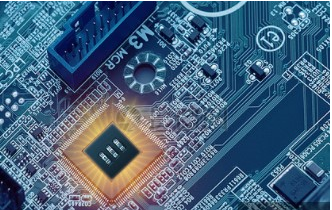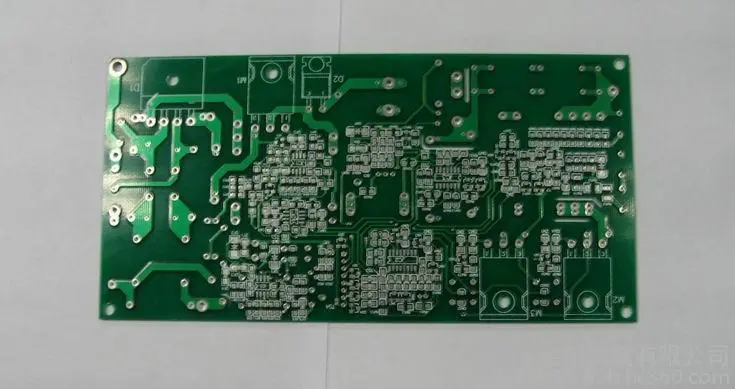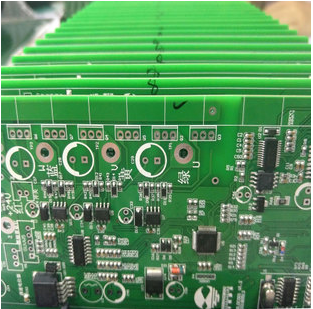
Whether the amplifier gets current from this power supply or another power supply depends on the instantaneous polarity of the signal on the load. The current flows out of the power supply, through the bypass capacitor, and into the load through the amplifier. Then, the current returns to the ground plane from the load ground terminal (or the shield of the PCB output connector), passes through the bypass capacitor, and returns to the power supply that originally provided the current.
The concept of the least impedance path through which current flows is incorrect. The amount of current in all different impedance paths is proportional to its conductivity. In a ground plane, there is often more than one low impedance path through which a large proportion of the current flows: one path is directly connected to the bypass capacitor; The other excites the input resistor before reaching the bypass capacitor.

When the bypass capacitor is placed at different positions of the PCB, the ground current flows to the respective bypass capacitor through different paths, which is the meaning represented by "spatial nonlinearity". If a large part of the component of a certain polarity of the ground current flows through the ground of the input circuit, only the component voltage of this polarity of the signal will be disturbed. If the other polarity of the ground current is not disturbed, the input signal voltage changes in a nonlinear way. When one polarity component is changed and the other polarity is not changed, distortion will be generated, which is shown as the second harmonic distortion of the output signal.
PCB design When only one polarity component of the sine wave is disturbed, the generated waveform is no longer a sine wave. Use a 100 Ω load to simulate an ideal amplifier, make the load current pass through a 1 Ω resistor, and only couple the input ground voltage on one polarity of the signal, then the results shown are obtained. Fourier transform shows that the distortion waveform is almost all the second harmonic at - 68dBc. When the frequency is very high, it is easy to generate this degree of coupling on the PCB. It can destroy the excellent anti distortion characteristics of the amplifier without resorting to too many special nonlinear effects of PCB. When the output of a single operational amplifier is distorted due to the ground current path, the ground current flow can be adjusted by rearranging the bypass circuit, and the distance from the input device can be maintained.
The problem of designing multiple amplifier chips (two, three or four amplifiers) with PCB is more complicated, because it cannot make the ground connection of bypass capacitor far away from all input terminals. This is especially true for four amplifiers. Each side of the quad amplifier chip has an input, so there is no space to place bypass circuits that can mitigate the disturbance to the input channels.
A simple method of four amplifier layout is given. Most PCB devices are directly connected to the four amplifier pins. The ground current of one power supply can disturb the input ground voltage and ground current of another channel power supply, resulting in distortion. For example, the (+Vs) bypass capacitor on channel 1 of four amplifiers can be directly placed near its input; The (Vs) bypass capacitor can be placed on the other side of the package. (+Vs) ground current may disturb channel 1, while (- Vs) ground current may not.
PCB design harmonic distortion
To avoid this problem, the ground current can disturb the input, but the PCB current can flow in a spatially linear manner. To achieve this purpose, bypass capacitors can be arranged on the PCB in the following way: (+Vs) and (– Vs) ground currents flow through the same path. If the positive/negative current perturbs the input signal equally, no distortion will occur. Therefore, the two bypass capacitors are arranged next to each other so that they share a ground point. Since the two polarity components of the ground current come from the same point (output connector shield or load ground) and return to the same point (common ground connection of bypass capacitor), both positive and negative currents flow through the same path. If the input resistance of a channel is disturbed by (+Vs) current, (– Vs) current has the same effect on it. No matter what the polarity is, the generated disturbance is the same, so no distortion will occur, but the channel gain will change slightly.
To verify the above inference, two different PCB layouts are used: simple layout and low distortion layout. The typical bandwidth of FHP3450 is 210MHz, the slope is 1100V/us, the input bias current is 100nA, and the working current of each channel is 3.6mA. It can be seen from Table 1 that the more distorted the channel, the better the improvement effect, so that the performance of the four channels is nearly equal.
If there is not an ideal four amplifier on the PCB, it is difficult to measure the effect of a single amplifier channel. Obviously, a given amplifier channel not only disturbs its own input, but also disturbs the input of other channels. The ground current flows through all different channel inputs and produces different effects, but is affected by each output. This effect is measurable.
PCB design gives the harmonics measured on other channels that are not driven when only one channel is driven. The non driven channel shows a small signal (crosstalk) at the basic frequency, but without any significant basic signal, it also generates distortion directly introduced by the ground current.
In short, on the PCB, the ground return current flows through different bypass capacitors (for different power supplies) and the power supply itself, and its size is proportional to its conductivity. High frequency signal current flows back to small bypass capacitor. Low frequency current (such as the current of audio signal) may mainly flow through the larger bypass capacitor. Even the current with lower frequency may "ignore" the existence of all bypass capacitors and directly flow back to the power lead. The specific application will determine which current path is most critical. Fortunately, by using a common ground point and a ground bypass capacitor on the output side, all ground current paths can be easily protected.
The golden rule of high frequency PCB layout is to make the high frequency bypass capacitor as close to the packaged power pin as possible, so modifying this rule to improve the distortion characteristics will not bring too much change. The improvement of the distortion characteristic is at the cost of adding about 0.15 inch long high-frequency bypass capacitor routing, but this has little impact on the AC response performance of the FHP3450. PCB layout is very important to give full play to the performance of a high-quality amplifier. The issues discussed here are not limited to high-frequency amplifiers. Lower frequency signals such as audio require much more distortion. The ground current effect is smaller at low frequencies, but it may still be an important problem if the required distortion index is required to be improved accordingly.







